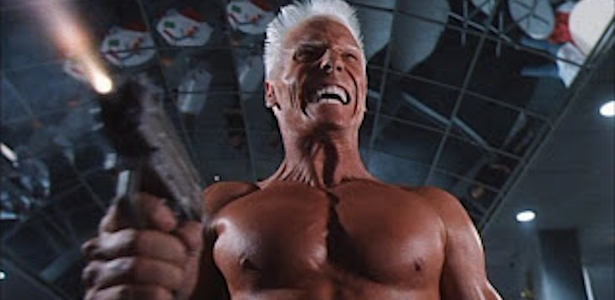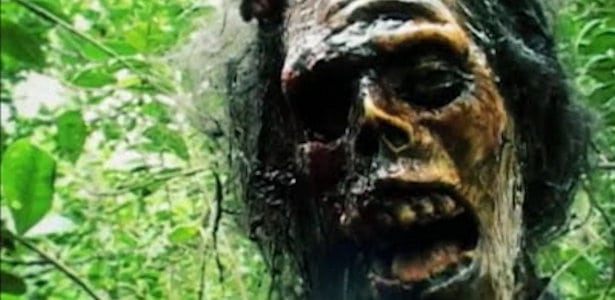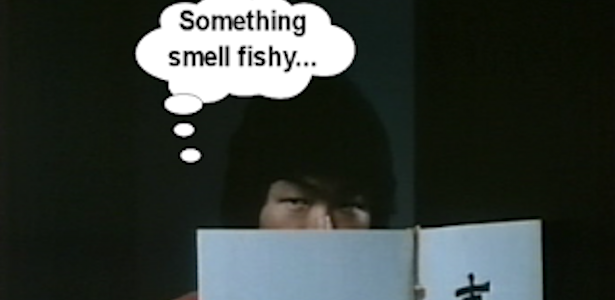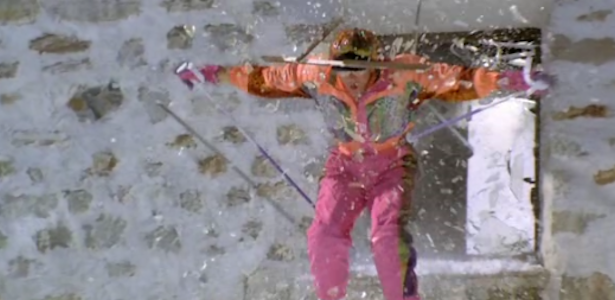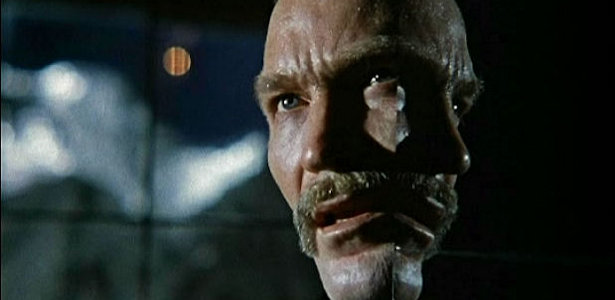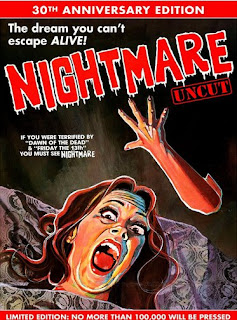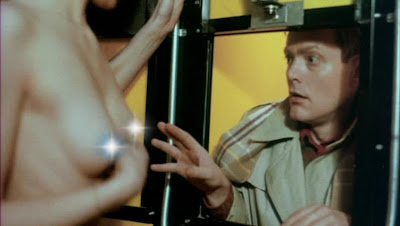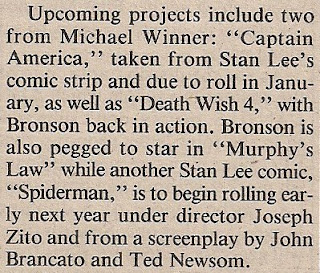I can still remember the feeling I had after I first rented Romano Scavolini’s NIGHTMARE on VHS. It was the same feeling I have after renting Juan Piquer Simon’s PIECES. I felt dirty. How are you supposed to feel after watching a film that opens with a guy waking up from a nightmare, only to pull back his sheets and see the end of his bed covered in viscera and a severed head that opens its eyes? I probably made sure no one was watching as I slid it in the return drop box at the video store. I had seen umpteenth horror and gore films, but NIGHTMARE seemed to pass them all due to its griminess. It sits right next to Ulli Lommel’s THE BOOGEYMAN (1980) in shamelessly and explicitly connecting sex and violence.
That comparison is apt since NIGHTMARE, like Lommel’s film, is essentially John Carpenter’s HALLOWEEN (1978). The tagline could read “the night he came home to Florida!” The only difference is we never got to see Michael Myers go to a Times Square strip joint or roll around on a hotel bed while crying in his underwear. This is HALLOWEEN with the sleaze factor pushed up to ten. Mental patient George Tatum (Baird Stafford) keeps having a series of nightmares involving a kid in a bowtie. Scary, I know. A team of psychiatrists try an experimental drug on him which seems to work and George is soon released back into the general public in New York City.
George hits up the aforementioned nude revue and seeing bare female flesh sends him over the edge in a fit of convulsions. The next thing we know, he driving down the East Coast to Florida. His purpose is to stalk young single mother Susan Temper (Sharon Smith) and her three children. George shows more interest in her nine-year-old son C.J. (C.J. Cooke) and begins a threatening series of obscene phone calls. Meanwhile, back in New York, his psychiatrists are flipping out since their lab rat hasn’t reported for his counseling sessions. The hunt is on as they try to track George’s movements through their big computer. But will they get to the Temper family in time and why on Earth did George choose to stalk this specific family several states away (you’ll figure it out, which makes you smarter than his doctors)?
NIGHTMARE is one of those films that you never forget. Or so I thought. Revisiting this after nearly 20 years, I remembered the first 15 minutes set in New York and the insane finale vividly. However, I completely forgot the rest of the movie in the middle. And it is probably for good reason as that whole section is completely forgettable outside of a few kills here and there. If you are a fan of single moms yelling at their kids, then this hour middle section is totally for you. I am a fan of the Florida location shooting though as this carries that same kind of rancid beach town feel as classics like THE SLAYER (1982) and THE MUTILATOR (1985). On the plus side, Scavolini takes what Carpenter did and pushes it all a step further. The finale has kids in peril from a masked maniac, but the crazy Italian makes sure to have young C.J. being the one to take care of business as he fires six shots into the killer and then blows him away with a shotgun for good measure. Scavolini also tries hard to make some points about how sex and violence are interconnected. He delves into the psychology of what happens when a little kid witnesses both of these things, but his point is pretty muffled by the over-the-top sex and violence. The only real lesson I really learned from this is if you are going to hire a lady to tie you up and slap you around, make sure you lock the door to the bedroom before doing the deed.
of single moms yelling at their kids, then this hour middle section is totally for you. I am a fan of the Florida location shooting though as this carries that same kind of rancid beach town feel as classics like THE SLAYER (1982) and THE MUTILATOR (1985). On the plus side, Scavolini takes what Carpenter did and pushes it all a step further. The finale has kids in peril from a masked maniac, but the crazy Italian makes sure to have young C.J. being the one to take care of business as he fires six shots into the killer and then blows him away with a shotgun for good measure. Scavolini also tries hard to make some points about how sex and violence are interconnected. He delves into the psychology of what happens when a little kid witnesses both of these things, but his point is pretty muffled by the over-the-top sex and violence. The only real lesson I really learned from this is if you are going to hire a lady to tie you up and slap you around, make sure you lock the door to the bedroom before doing the deed.
One of the more interesting things from my revisit was seeing how my amazingly refined sense of humor had grown. As a teenager, I didn’t pick up on the unintentional comedic value in this film. For example, there is a bit where the cops drag C.J. and his mom to a crime scene in the middle of the night to identify his dead friend. Not only that, the cops decide it is best to interrogate the kid right there in front of the dead kid’s body. I love that the mom gets these harassing phone calls and never puts together that it might be her crazy ex-husband. And Scavolini has the wildest belief in how phones work. In his mind, you can call the downstairs phone from the upstairs phone in the same house. My favorite is how dumb George’s doctors are. They can trace his movements via their computer and have it guestimate where he will go, but can’t put together why he is heading to this town. Never got any records about a kid with the same name from the same town murdering two folks there? And it never came up that he was married with three kids and they live in that town too? Was there no Google search on their super computer? There is a great bit where Paul, his main doc, argues there is no way George can be in Florida and all the similar names are just coincidences. When told of the police report of the young George murder from 25 years ago, he says, “Oh my God.” He isn’t shocked because of the realization that they are right and George is in Florida. He’s shocked because at that moment he realized what a shitty psychiatrist he is, never having asked something like, “Is there anything in your past that may have triggered these nightmares?” Dr. Freud he ain't. Hell, Dr. Loomis he ain’t!
front of the dead kid’s body. I love that the mom gets these harassing phone calls and never puts together that it might be her crazy ex-husband. And Scavolini has the wildest belief in how phones work. In his mind, you can call the downstairs phone from the upstairs phone in the same house. My favorite is how dumb George’s doctors are. They can trace his movements via their computer and have it guestimate where he will go, but can’t put together why he is heading to this town. Never got any records about a kid with the same name from the same town murdering two folks there? And it never came up that he was married with three kids and they live in that town too? Was there no Google search on their super computer? There is a great bit where Paul, his main doc, argues there is no way George can be in Florida and all the similar names are just coincidences. When told of the police report of the young George murder from 25 years ago, he says, “Oh my God.” He isn’t shocked because of the realization that they are right and George is in Florida. He’s shocked because at that moment he realized what a shitty psychiatrist he is, never having asked something like, “Is there anything in your past that may have triggered these nightmares?” Dr. Freud he ain't. Hell, Dr. Loomis he ain’t!
Finally hitting DVD via Code Red after a 5-year or so delay, NIGHTMARE gets a nice 30th anniversary special edition. They offer you three transfers of the film. The one I watched looks great for the most part, but has some scratches around the reel change. That doesn’t bother me at all as it almost seems fitting for a movie this sleazy. But I’m sure it will rile up some folks online. What is a bone of contention that they should have is the 95 minute interview with Scavolini that is presented in Italian with no subtitles! Seriously. Other bonus features include an audio commentary with make up artist Cleve Hall and Baird Stafford, a “Making of a Nightmare” interview with Stafford, Hall and 21st Century head Tom Ward, an interview with FX guy Edward French and trailers. The “making of” is great as Hall covers the FX work he did and the Tom Savini controversy. And Stafford offers some revealing personal information that will make you see the film in a whole new light. Definitely recommended.
That comparison is apt since NIGHTMARE, like Lommel’s film, is essentially John Carpenter’s HALLOWEEN (1978). The tagline could read “the night he came home to Florida!” The only difference is we never got to see Michael Myers go to a Times Square strip joint or roll around on a hotel bed while crying in his underwear. This is HALLOWEEN with the sleaze factor pushed up to ten. Mental patient George Tatum (Baird Stafford) keeps having a series of nightmares involving a kid in a bowtie. Scary, I know. A team of psychiatrists try an experimental drug on him which seems to work and George is soon released back into the general public in New York City.
George hits up the aforementioned nude revue and seeing bare female flesh sends him over the edge in a fit of convulsions. The next thing we know, he driving down the East Coast to Florida. His purpose is to stalk young single mother Susan Temper (Sharon Smith) and her three children. George shows more interest in her nine-year-old son C.J. (C.J. Cooke) and begins a threatening series of obscene phone calls. Meanwhile, back in New York, his psychiatrists are flipping out since their lab rat hasn’t reported for his counseling sessions. The hunt is on as they try to track George’s movements through their big computer. But will they get to the Temper family in time and why on Earth did George choose to stalk this specific family several states away (you’ll figure it out, which makes you smarter than his doctors)?
NIGHTMARE is one of those films that you never forget. Or so I thought. Revisiting this after nearly 20 years, I remembered the first 15 minutes set in New York and the insane finale vividly. However, I completely forgot the rest of the movie in the middle. And it is probably for good reason as that whole section is completely forgettable outside of a few kills here and there. If you are a fan
 of single moms yelling at their kids, then this hour middle section is totally for you. I am a fan of the Florida location shooting though as this carries that same kind of rancid beach town feel as classics like THE SLAYER (1982) and THE MUTILATOR (1985). On the plus side, Scavolini takes what Carpenter did and pushes it all a step further. The finale has kids in peril from a masked maniac, but the crazy Italian makes sure to have young C.J. being the one to take care of business as he fires six shots into the killer and then blows him away with a shotgun for good measure. Scavolini also tries hard to make some points about how sex and violence are interconnected. He delves into the psychology of what happens when a little kid witnesses both of these things, but his point is pretty muffled by the over-the-top sex and violence. The only real lesson I really learned from this is if you are going to hire a lady to tie you up and slap you around, make sure you lock the door to the bedroom before doing the deed.
of single moms yelling at their kids, then this hour middle section is totally for you. I am a fan of the Florida location shooting though as this carries that same kind of rancid beach town feel as classics like THE SLAYER (1982) and THE MUTILATOR (1985). On the plus side, Scavolini takes what Carpenter did and pushes it all a step further. The finale has kids in peril from a masked maniac, but the crazy Italian makes sure to have young C.J. being the one to take care of business as he fires six shots into the killer and then blows him away with a shotgun for good measure. Scavolini also tries hard to make some points about how sex and violence are interconnected. He delves into the psychology of what happens when a little kid witnesses both of these things, but his point is pretty muffled by the over-the-top sex and violence. The only real lesson I really learned from this is if you are going to hire a lady to tie you up and slap you around, make sure you lock the door to the bedroom before doing the deed.One of the more interesting things from my revisit was seeing how my amazingly refined sense of humor had grown. As a teenager, I didn’t pick up on the unintentional comedic value in this film. For example, there is a bit where the cops drag C.J. and his mom to a crime scene in the middle of the night to identify his dead friend. Not only that, the cops decide it is best to interrogate the kid right there in
 front of the dead kid’s body. I love that the mom gets these harassing phone calls and never puts together that it might be her crazy ex-husband. And Scavolini has the wildest belief in how phones work. In his mind, you can call the downstairs phone from the upstairs phone in the same house. My favorite is how dumb George’s doctors are. They can trace his movements via their computer and have it guestimate where he will go, but can’t put together why he is heading to this town. Never got any records about a kid with the same name from the same town murdering two folks there? And it never came up that he was married with three kids and they live in that town too? Was there no Google search on their super computer? There is a great bit where Paul, his main doc, argues there is no way George can be in Florida and all the similar names are just coincidences. When told of the police report of the young George murder from 25 years ago, he says, “Oh my God.” He isn’t shocked because of the realization that they are right and George is in Florida. He’s shocked because at that moment he realized what a shitty psychiatrist he is, never having asked something like, “Is there anything in your past that may have triggered these nightmares?” Dr. Freud he ain't. Hell, Dr. Loomis he ain’t!
front of the dead kid’s body. I love that the mom gets these harassing phone calls and never puts together that it might be her crazy ex-husband. And Scavolini has the wildest belief in how phones work. In his mind, you can call the downstairs phone from the upstairs phone in the same house. My favorite is how dumb George’s doctors are. They can trace his movements via their computer and have it guestimate where he will go, but can’t put together why he is heading to this town. Never got any records about a kid with the same name from the same town murdering two folks there? And it never came up that he was married with three kids and they live in that town too? Was there no Google search on their super computer? There is a great bit where Paul, his main doc, argues there is no way George can be in Florida and all the similar names are just coincidences. When told of the police report of the young George murder from 25 years ago, he says, “Oh my God.” He isn’t shocked because of the realization that they are right and George is in Florida. He’s shocked because at that moment he realized what a shitty psychiatrist he is, never having asked something like, “Is there anything in your past that may have triggered these nightmares?” Dr. Freud he ain't. Hell, Dr. Loomis he ain’t!Finally hitting DVD via Code Red after a 5-year or so delay, NIGHTMARE gets a nice 30th anniversary special edition. They offer you three transfers of the film. The one I watched looks great for the most part, but has some scratches around the reel change. That doesn’t bother me at all as it almost seems fitting for a movie this sleazy. But I’m sure it will rile up some folks online. What is a bone of contention that they should have is the 95 minute interview with Scavolini that is presented in Italian with no subtitles! Seriously. Other bonus features include an audio commentary with make up artist Cleve Hall and Baird Stafford, a “Making of a Nightmare” interview with Stafford, Hall and 21st Century head Tom Ward, an interview with FX guy Edward French and trailers. The “making of” is great as Hall covers the FX work he did and the Tom Savini controversy. And Stafford offers some revealing personal information that will make you see the film in a whole new light. Definitely recommended.
Sleazoid Express review, 11/81:
Box Office review from 1982:
Gore Gazette review (click to enlarge):
Fangoria covers the Savini FX controversy:
Chicago Shivers review
(courtesy of the great Temple of Schlock):




